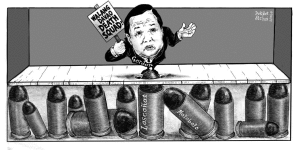The article “Radyo Bandido days recalled” (News, 2/22/17) contains selective accounts about Radyo Bandido that do not do justice to what really happened. Although other people who were at Radyo Bandido were also credited, they were mistakenly identified as “a volunteer network of theater actors under Jesuit priest James B. Reuter.”
June Keithley called me late on Feb. 22, 1986, and asked me to gather trusted friends to join her in the parking lot of the J&T building in Santa Mesa. June had become the voice of the opposition to President Ferdinand Marcos, but her radio broadcasts went off the air when Radio Veritas’ transmitter was bombed. Among our friends who turned up in Santa Mesa on Feb. 22 were: Peque Gallaga, Jaime Fabregas, Mario Taguiwalo, Kokoy Jimenez and Maryanne Borromeo. There were 16 of us at dzRJ that fateful night (including June Keithley and the Mercado boys).
When we went up to the tower, Father Reuter was there with a military man in civilian clothes, who managed to get the transmitter and some telephone lines operating. One line went directly to Gen. Fidel Ramos who was in Camp Crame. We quickly went to work—looking for music to play in between hastily written scripts. (That’s how we found “Mambo Magsaysay,” a campaign jingle from the 1950s, which became our signature song.)
I gave our radio station the name “Radyo Bandido” (in a nod to “Radyo Batibot,” because some of us were from “Batibot” and I was trying to find more volunteers). Our “field reporters” were random callers from all over Metro Manila who reported on troop movements and what people observed in the streets. (There were no cell phones then, only land lines.) We also had regular instructions from General Ramos (including not to alert people about armored military vehicles coming their way because he did not want to frighten them off the streets).
After several misleading calls, June prematurely announced that Marcos had fled. After that, we decided that June would not report anything until we had at least three confirmations (sightings from various callers). Later, we heard that loyalist troops (pro-Marcos forces) were trying to find us. I called my mother who called Jaime Cardinal Sin, hoping he would send us some protection. Cardinal Sin called the Assumption nuns and when they arrived, they sat on the spiral staircase leading up to the tower praying that no one would come to harm us. I do not remember exactly for how long we were on broadcast; I can only recall some of the calls I took and the stories I wrote (including several from an air traffic controller at the airport who confirmed through radar when the Marcoses finally left Malacañang). When the rebel troops took over PTV-4, General Ramos sent for us to join the other volunteers working there.
I do not know why June Keithley and Father Reuter never publicly acknowledged the work we did for Radyo Bandido. At the time, the rest of us decided to remain quiet because we felt that Edsa needed its heroes and to contradict June’s accounts of what happened might cast doubts about her truly heroic efforts. Some of us who were there that night are gone now, but some of us are still here. It is in their honor that I write my recollections of Radyo Bandido.
LYCA BENITEZ BROWN, former executive director of Batibot, lbbrown@pwu.edu.ph


